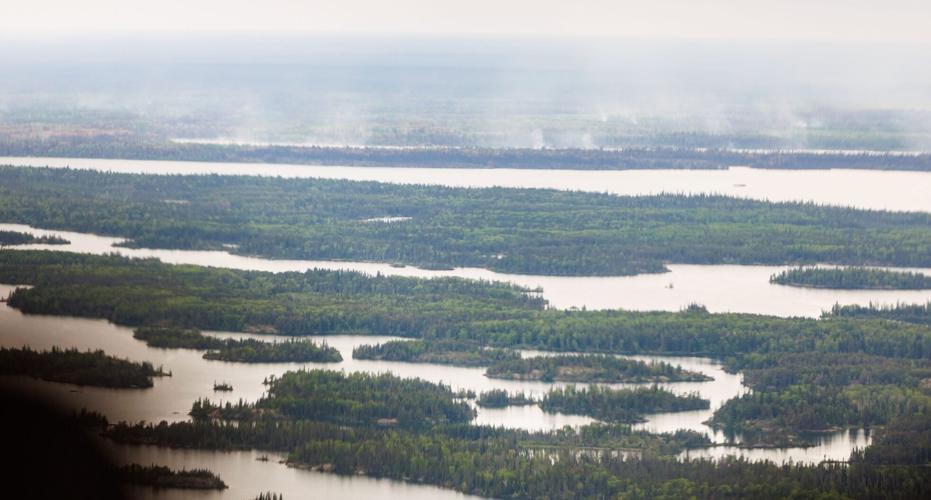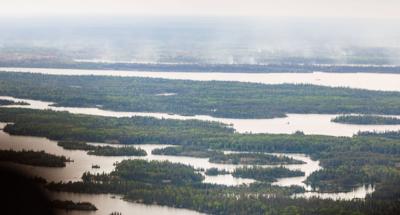Wildfire smoke from the Prairies is spreading to É«É«À², causing hazy skies and potentially health hazardous air quality.Â
According to the province, downtown É«É«À²Â is experiencing high risk (level 7 out of 10) air quality on Thursday as wildfires burn in parts of the country including Manitoba, Saskatchewan and Alberta.Â
As smoke drifts into southern Ontario, Environment Canada is asking people to limit the time they spend outside because, as smoke levels rise, so do associated health risks.
Some É«É«À² residents have reported hazy conditions with the air smelling like a forest fire, however, experts are only mildly concerned with the smoke.Â
The Minnesota Pollution Control Agency issued an air quality alert for much of state through Wednesday as smoke from wildfires burning in Canada settled across the upper Midwest. (AP Video / June 3, 2025)
Here’s what you need to know about É«É«À²’s air and how to protect yourself.Â
What is É«É«À²’s air quality like this week?Â
Environment Canada’s forecast is calling for smoke to drift from forest fires devastating the Prairies to Southern Ontario.
The wildfire smoke will cause poor air quality and reduced visibility on Thursday, changing over short distances and considerably from hour to hour, according to the government agency.
Early Thursday morning, É«É«À² had some of the worst air quality in the world that was high risk to health, but conditions are expected to clear up by the evening when air quality is projected to drop to a moderate level before a low risk of 3 in the night.
Skies are expected to improve from north to south.
This comes as É«É«À² experienced a week of scorching heat and humidity, but with Thursday arrived some relief from the hot weather as temperatures dipped to a pleasant high of 23 C and low of 14 C.Â
Should I be worried about the air quality in É«É«À²?Â
Air quality throughout the province is being affected by smoke from the wildfires but “it’s not the same level that we were seeing almost exactly two years ago in 2023, early June, when the skies were very dark and we were having record levels of air pollution,” said Rebecca Saari, a University of Waterloo associate professor who researches air pollution and it’s health impacts.
“Part of the reason is that we don’t have the same fires in Quebec, that were also joining with the western fires. That’s what made 2023 so bad, but right now, it’s just fires mainly to the west of the province and some in the northwest that we’re contending with.”
Saari said as it’s a moderate risk in É«É«À², those who are not vulnerable to the effects of the smoke can continue to go outside and breathe the air but those who are sensitive to polluted air should steer clear of the outdoors and consider rescheduling vigorous outdoor activities, especially if they’re having symptoms.Â
For healthy adults, Saari said “there’s no need to panic. Their risk is moderate. It’s not a major acute concern,” but she noted that the situation may change rapidly depending on how the fire evolves, if new fires develop and if wind patterns change. However, she does note that the more days with moderate levels of bad air can lead to higher exposure over the year and potentially risk health.Â
Who is most at risk from polluted air from wildfire smoke?Â
Sensitive groups most at risk of wildfire smoke air pollution include seniors, children, pregnant women, people with chronic diseases such as asthma and underlying health conditions such as heart and lung diseases.
Common symptoms caused by inhalation of smoky air include irritation of the eyes, nose, throat or lungs and for people who have pre-existing chronic conditions, the exposure of wildfire smoke may worsen their symptoms.Â
The Canadian Ophthalmological Society offers tips to protect your eyes as wildfire smoke blankets parts of Canada. (June 6, 2025 / The Canadian Press)
How can I protect myself from wildfire smoke?Â
The best way to protect yourself from breathing in bad air caused by smoke from wildfires is to stay indoors, said Saari, but for those who can’t stay inside and are required to work outdoors, they are recommended to wear a well-fitting respirator-type mask such as an N95 or P100.Â
The masks are designed to reduce exposure to smoke by filtering out fine particulate matter. Wearing a mask and making sure you wear it properly prevents the particles from getting into the lungs and body.Â
“If you are outdoors for a prolonged period of time to do work, you also need to consider reducing the intensity of the work that you’re doing and take breaks more frequently and ideally have a cleaner air shelter that you can go in and get some relief,” said Angela Yao, a senior scientist with Environmental Health Services at the B.C. centre for Disease Control.
Yao points out that masks may become less effective if they build moisture through wearing it while exercising. Her advice is to shorten the length of time you spend outside and reduce the intensity of the outdoor activity.Â
Saari said staying indoors doesn’t guarantee safety from the smoke if steps aren’t taken to keep the smoke out. Those staying inside are advised to have windows and doors closed as much as possible and to keep indoor air clean, which could mean running a ventilation system and air conditioning with a well-functioning filter or by using a portable air cleaner.
For those who live in homes without a built-in ventilation system who rely on an open window to cool down, Yao said to avoid wildfire smoke by visiting a public space with cleaner, cooler air ventilation such as a shopping mall or library.Â
What to do before heading outside when there’s poor air quality?
With É«É«À² finally getting a taste of summer this week , Saari and Yao both recommend checking the local air quality health index and to make it part of their daily routine.Â
“Sometimes wildfire smoke can linger for a long period of time, so it’s crucial to know when it’s a better time to go out,” Yao said.Â

































To join the conversation set a first and last name in your user profile.
Sign in or register for free to join the Conversation